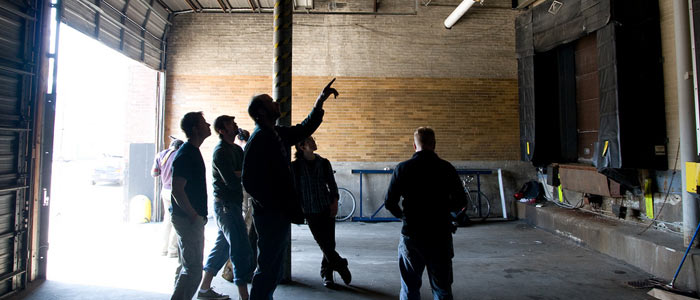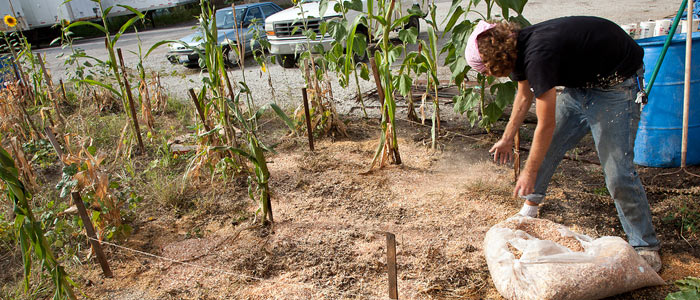There’s little to distinguish the old brick building from the dozens that surround it in this end of the former stockyards. The brickwork is the same with its smokestacks — worn-out reminders of the plant’s former purpose. The only incongruous details are the half-dozen tomato plants growing in mounds of dirt and the small, sun-faded sticker on the door that says “The Plant.” It took me a thirty-minute bus ride to get to this back end of the old stockyards, where one possible future of urban agriculture is being slowly built.
“There’s going to be plants everywhere,” John Edel tells our assembled tour group. “From the moment you walk into the building, it’s going to be like walking into a conservatory.”
So The Plant is not, technically speaking, an urban farm. At the moment, it’s a former meatpacking plant in the middle of a slow renovation process, with a few tiny indoor growing operations and some big plans. But it’s worth an investigation, and I’m not the first to think so. The Reader did a story on the Plant last August, and the Tribune covered it in April. Even Time Out Chicago wrote a piece about the Plant. It’s easy to see why it’s garnered such interest: The Plant is set to be a revolutionary force in 21st century agriculture.
Edel was the guiding force behind the Chicago Sustainable Manufacturing Center, also known as Bubbly Dynamics. In 2005, Edel bought and renovated a 24,000 square foot derelict building using recycled and scavenged materials, transforming it into a space for artists, educators and artisans. The building features a roof garden and water reclamation systems.

Edel’s ideas for The Plant are even more ambitious. Edel leads our tour group through a maze of rooms, pointing out areas of bare brick and concrete rubble and describing the room’s future incarnation: shared kitchens, living walls, a 30 barrel brewhouse for the New Chicago Brewing Company, offices, fish tanks, hoop houses, a mycology lab, an orchard. The Plant is going to be so much more than a farm. Edel is trying to create an entirely new agricultural model, one that can transform the swaths of abandoned industrial districts across the country, such as the old stockyards. He eventually plans to employ over 125 people at the Plant, once the project is off the ground.

It’s hard to imagine at the moment. The interior of The Plant is thick with the smells of dust, soot and mildew. Volunteers heft sledgehammers and metal saws. Parts of the concrete floor are torn up. The rail system on the ceiling, where a few years ago held the bodies of slaughtered pigs waiting to be smoked, is still intact in some places (Edel intends to leave it up there, as a reminder of the Plant’s former life).
The idea of vertical farming has been gaining interest in the last few years. Futurists, ecologists and urban planners have all been touting vertical farms — where the whole process of growing, cultivating and harvesting food takes place inside — as the wave of the future, a viable way to grow enough food for a city within the city’s limits. Most current models of vertical farms are lofty skyscrapers, full of shining windows and carefully constructed AutoCAD greenscapes.
The Plant, even in its current gestational stage, is already more down-to-earth. By using a derelict industrial building, and by recycling and scavenging as much of the materials it can, Edel and his team are hoping to keep building costs extremely cheap. His big dreams are rooted in a kind of practical mentality I’ve seen in many farmers: Edel may be a dreamer, and the Plant may be an experiment, but Edel is taking the steps to make this experiment practical, cheap and repeatable by others. Besides keeping building costs as low as possible, Edel’s taking steps to offset the high energy costs of indoor farming by using an anaerobic digester to create power for the plant. The digester will be fed by spent grains from the brewery, waste from the fish farm and kitchens and food waste from other businesses and manufacturers in the area. In turn, this sludge will be turned into biogas, which will power a generator. The turbine will create electricity for the plant, as well as carbon dioxide for the hydroponic plant beds. The Plant will function much like a living organism, with all of its disparate parts feeding into each other. Recently, The Plant received $1.5 million from the Illinois Department of Commerce and Economic Opportunity to make the facility energy independent, meaning it will be completely off of Chicago’s power grid.
Edel eventually leads us into the aquaponics room, and the smells of concrete dust and old soot are replaced by flowing water and growing plants. Tilapia fry stare out from aquaria on a desk. Rows of green plants are bathed in a purple light — Edel explains that most plants only respond to red and blue lightwaves and that using the rest of the spectrum is unnecessary. Edel points out the pipes connecting the plant beds with the 250 gallon fish tanks, like ones you can find on Fishlab, where adult tilapia swim in ponderous circles, shows us the filters, the arduino processors that control the movements of the light fixtures. Volunteers walk past us, carrying equipment to measure different data from the tanks and the plants. Edel talks about the zoning codes, the obstacles he has to overcome, the hurtles he’s already cleared and the very real progress he’s made, before he’s distracted.

The lettuce in the plant beds has been roughly harvested, with browning stalks and orphaned leaves littering the bed. “This looks terrible, sorry,” Edel apologizes, frowning at it. “I’m not sure what happened there.”
“We ate that for lunch,” one of the volunteers calls out.
“Oh, right,” Edel says, smiling.
The Plant offers tours every Monday, Thursday and Saturday at 2pm. More information can be found at the Plant’s blog, or you can get updates on their Twitter or Facebook page.